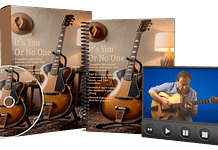This post may contain affiliate links. As an Amazon associate, Google associate as well as associate for other programs, Guitar & Music Institute may earn commissions from qualifying purchases.
 Playing guitar techniques is essential for any beginner guitarist looking to improve their skills. These techniques add flair and finesse to your playing, making your music more appealing and unique. Whether you’re just starting out or have been playing for a while, mastering beginner guitar techniques is key to becoming a more confident and versatile player.
Playing guitar techniques is essential for any beginner guitarist looking to improve their skills. These techniques add flair and finesse to your playing, making your music more appealing and unique. Whether you’re just starting out or have been playing for a while, mastering beginner guitar techniques is key to becoming a more confident and versatile player.
From guitar exercises for beginners to easy and basic guitar techniques, there are plenty of resources available to help you learn and master these essential skills. If you’re unsure where to start, beginner guitar lessons can provide a solid foundation and guide you through each technique, step by step.
By dedicating time and practice to learning beginner guitar techniques, you’ll develop essential skills that will not only enhance your playing but also open doors to more complex techniques in the future. It’s important to take your time, be patient with yourself, and focus on building a strong foundation.
Key Takeaways:
- Mastering beginner guitar techniques is essential for any aspiring guitarist.
- These techniques add flair and finesse to your playing, making your music more appealing and unique.
- Beginner guitar lessons can provide a solid foundation for learning essential techniques.
- Take your time, be patient, and focus on building a strong foundation.
Understanding Riffs and Licks
Riffs and licks are terms often used interchangeably in the world of guitar playing, but it’s important to understand their subtle differences. A riff refers to a sequence of notes or chords that form the backbone of a song. It is a recurring musical motif that hooks the listener, setting the tone and creating a memorable melody. Riffs can be simple or complex, but they are always an integral part of a composition.
On the other hand, a lick is a short musical phrase or improvisation that guitarists come up with during a performance or recording. Licks are often used as embellishments or solos within a song, showcasing the guitarist’s creativity and technical skill. Unlike riffs, licks are not typically part of the song’s structure and can vary from one performance to another.
Now let’s take a look at some iconic guitar riffs that have become synonymous with legendary songs. These riffs are instantly recognizable and have left an indelible mark on the history of rock and pop music:
| Song | Artist |
|---|---|
| “Sweet Child ‘O Mine” | Guns N’ Roses |
| “Nothing Else Matters” | Metallica |
| “Stairway to Heaven” | Led Zeppelin |
| “Smoke on the Water” | Deep Purple |
These iconic guitar riffs have become part of the cultural fabric, influencing generations of guitarists and music lovers alike. They demonstrate the power of a well-crafted riff in captivating audiences and leaving a lasting impression.
By understanding the difference between riffs and licks, you can enhance your guitar playing skills and develop a deeper appreciation for the role they play in music. Whether you’re learning to play iconic riffs or improvising captivating licks, both elements contribute to your growth as a guitarist.
Remember, mastering riffs and licks takes practice and dedication. So keep honing your skills, experimenting with different styles, and exploring the vast world of guitar playing.
Essential Beginner Guitar Techniques
As a beginner guitarist, it’s crucial to focus on mastering essential techniques that will lay a solid foundation for your playing. These techniques will not only enhance your skills but also allow you to create a wide range of music. Let’s explore the 15 essential beginner guitar techniques that you should learn:
- Hammer-on and pull-off: These techniques involve using your fretting hand to produce legato notes without picking the string again.
- Sliding: Sliding enables you to smoothly transition between different notes by moving your fretting hand along the neck of the guitar.
- Vibrato: Vibrato adds a unique and expressive quality to your playing by quickly bending and releasing a note.
- Double-stops: With double-stops, you play two notes simultaneously to create harmonies and melodic intervals.
- Arpeggios: Arpeggios involve playing the individual notes of a chord in sequence, creating a flowing and melodic sound.
- Bending: Bending allows you to change the pitch of a note by pushing or pulling the string vertically.
- Finger-picking: Finger-picking involves using your fingers to pluck the strings individually, allowing for intricate melodies and patterns.
- Dead notes: Dead notes are muted sounds produced by lightly touching the strings with your fretting hand without pressing them down.
- Alternate picking: Alternate picking is a technique where you alternate between downward and upward strokes with your pick, creating a fluid and precise motion.
- Palm muting: By resting the palm of your picking hand lightly on the strings near the bridge, you can achieve a muted and percussive effect.
- Tapping: Tapping involves using your picking hand to tap on the fretboard to produce quick and precise notes.
- Natural harmonics: Natural harmonics are bell-like tones created by lightly touching specific frets on the strings while picking them.
- Pinched harmonics: Also known as artificial harmonics, pinched harmonics are produced by lightly touching the strings with your picking hand while picking them.
- Sweep picking: Sweep picking is a technique where you use a fluid motion to brush across multiple strings with a pick, creating a fast and smooth sound.
- Legato: Legato refers to playing notes smoothly and connectedly, usually by using hammer-ons and pull-offs.
Learning and mastering these essential beginner guitar techniques will establish a strong foundation for your playing and open up a world of possibilities. Practice them regularly and incorporate them into your playing to take your guitar skills to the next level.
Check out our latest free and paid guitar books and downloads at gmiguitarshop.com.

Advancing Your Guitar Techniques
Once you’ve mastered the essential beginner techniques, it’s time to push the boundaries and explore more advanced guitar techniques. These techniques will elevate your playing to new heights, allowing you to create intricate and impressive sounds. Let’s dive into some advanced techniques that you can incorporate into your guitar repertoire.
Sweep Picking
Sweep picking is a technique that involves playing arpeggios with a continuous motion of the picking hand. This technique is commonly used in genres like metal and fusion, adding speed and fluidity to your playing. It requires precise coordination between your picking hand and fretting hand to achieve clean and smooth arpeggio sweeps.
Economy Picking
Economy picking is a technique that combines elements of alternate picking and sweep picking. It involves using the most efficient picking motion for each note, minimizing excess movement and maximizing speed. This technique allows for fast and fluid runs across the strings, making it a valuable tool for shredding.
Hybrid Picking
Hybrid picking combines picking with both the pick and the fingers of the picking hand. This technique offers greater versatility and allows for intricate and complex picking patterns. By using your fingers to pluck the strings, you can achieve a smooth and dynamic sound, especially when combined with the pick.
Palm Muting
Palm muting is a technique where the palm of your picking hand lightly rests on the strings near the bridge, dampening the sound and creating a muted effect. This technique is commonly used in rock and metal to add a heavy and percussive sound to your playing. It’s a great way to add dynamics and variation to your riffs and solos.
Hammer-Ons with Slides
Hammer-ons with slides are techniques that involve hammering-on a note and quickly sliding to another note on the same string. This creates a seamless transition between the two notes and adds a smooth and expressive quality to your playing. It’s commonly used in blues and rock guitar solos to achieve fluid and melodic lines.
Tapping Arpeggios
Tapping arpeggios is a technique where you use your picking hand to tap notes on the fretboard, producing a fast and virtuosic sound. This technique is popular in rock and metal guitar solos and allows for the execution of complex arpeggios with ease. It requires precise coordination and finger strength to achieve accuracy and speed.
By incorporating these advanced guitar techniques into your playing, you’ll be able to showcase your skill and creativity on the instrument. Practice each technique with dedication and patience, gradually increasing your speed and accuracy. Remember, mastering these techniques takes time, so don’t get discouraged if it feels challenging at first. With consistent practice, you’ll be able to add complexity and depth to your guitar playing.
Check out our latest free and paid guitar books and downloads at https://gmiguitarshop.com/ for more resources to enhance your guitar skills.

Conclusion
Learning and mastering beginner guitar techniques is essential for any aspiring guitarist. These techniques will enhance your playing, add flair to your music, and allow you to create unique sounds. By starting with the essential techniques and gradually advancing to more complex ones, you can continuously improve your guitar skills and become a confident guitarist. Remember to practice regularly and have fun with your guitar journey!
For more resources and further guidance, check out our latest free and paid guitar books and downloads at https://gmiguitarshop.com/. Whether you’re a beginner or an experienced player, our collection offers a wide range of materials that can help you refine your technique, expand your repertoire, and take your guitar playing to the next level.
So, grab your guitar, dive into the world of beginner guitar techniques, and let your creativity shine. With dedication, practice, and a solid foundation of these essential techniques, you’ll be well on your way to becoming the guitarist you aspire to be. Start your musical journey now and unlock the full potential of your guitar playing!
FAQ
Why are guitar techniques important for beginners?
Guitar techniques are important for beginners because they add flair and finesse to your playing, making your music more appealing and unique.
What are some popular guitar techniques for beginners?
Some popular guitar techniques for beginners include slides, vibrato, legato, sweep-picking, pinch harmonics, bending, hammer-ons and pull-offs, and palm muting.
What is the difference between riffs and licks?
Riffs are sequences of notes or chords that are an integral part of a song, while licks are improvisations that guitarists come up with during a performance or recording.
Can you give examples of iconic guitar riffs?
Some well-known examples of iconic guitar riffs include “Sweet Child ‘O Mine,” “Nothing Else Matters,” “Stairway to Heaven,” and “Smoke on the Water.”
What are some essential beginner guitar techniques?
Some essential beginner guitar techniques include hammer-ons and pull-offs, sliding, vibrato, double-stops, arpeggios, bending, finger-picking, dead notes, alternate picking, palm muting, tapping, natural harmonics, pinched harmonics, sweep picking, and legato.
What are some advanced guitar techniques to explore?
Some advanced guitar techniques to explore include sweep picking, economy picking, hybrid picking, palm muting, hammer-ons with slides, and tapping arpeggios.
Why is it important to learn and master beginner guitar techniques?
Learning and mastering beginner guitar techniques is important because these techniques enhance your playing, add flair to your music, and allow you to create unique sounds.
Source Links
- https://www.theguitarhead.com/blogs/guitar-tips/quick-guide-to-guitar-techniques-for-beginners
- https://www.guitarlessonworld.com/lessons/7-beginner-guitar-playing-techniques/
- https://deviantnoise.com/guitar/techniques/
This post may contain affiliate links. As an Amazon associate, Google associate as well as associate for other programs, Guitar & Music Institute may earn commissions from qualifying purchases.



















